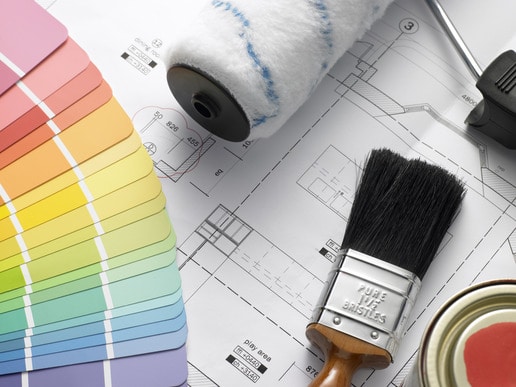7 Painting Tips For A Professional Job Every Time
If you’re considering a paint project for your home, our pros have a few painting tips to help the process go smoothly.
Start by cleaning
Your walls have marks, grease spots, oily residue and things you’re not even sure what they are. A good paint job will cover them all, right? Not so fast. Depending on what the stain is made from, you may end up covering it only to see it shine through as soon as it dries. And that defeats the purpose of a new paint job. Part of having a professional job is doing the necessary prep work first. That means cleaning, sanding, scraping, and making sure the walls are in prime condition to receive the paint in the first place.
Don’t skimp on equipment
Think you can be a professional photographer with an iPhone camera? In most cases, the answer is no.
In order to be a true professional, you have to have the proper equipment. The same holds true for a painter. And for a painter, that means the proper paint brush. Bristles should be tapered and arranged in multiple lengths to form a slim tip – perfect for full coverage. Unfinished handles make it easier to hang on with sweaty hands. Copper or stainless steel ferrules won’t rust when you put them in and out of water multiple times. And a 2 ¼ inch angled sash brush is perfect for trim work, while a 3 inch brush works better for cutting in walls and ceilings.
Get rid of the paint swatches
Let’s say you want to change your bedroom color from boring beige to brilliant blue. How do you know what blue will fit best with your décor and your tastes? Hard to tell from a two inch color swatch, right? A professional painter knows there is a lot more to color than deciding on something you can barely see. That’s why we recommend narrowing your choice down to one to three colors, then painting a three foot by three foot square space on your walls. Live with it a couple of days to feel the ambiance in the room as you move from morning to night, daylight to night light.
Never over-buy paint cans
One of the most wasteful products we use is paint. It’s easy to think you’ll need more than you really do, or plan on having a little extra for touch ups. But do you really need a couple of extra gallons? Nope, you’ll most likely grow tired of the color before you use it all. And then you’ll be left with hazardous waste that you simply don’t know what to do with. As a rule of thumb, one gallon covers 400 square feet. To figure out your room size, multiply the length of your longest wall by the height, then multiply it by 4. So if your room was 12 feet by 8 feet, times 4 would give you 384 square feet. Or approximately one gallon of paint needed to finish the job. Two for a double coat.
Prep the room the right way
Have a lot of repair work in your room? With scraping, sanding and dust making, you’ll soon find remnants of your work all over your home. To keep the mess contained in the space you are working in, tape plastic tarps completely over the door frame to seal in the work you’re doing. You can also cover furniture immediately outside of the room for added protection.
Avoid the sales table
Everyone likes a good sale, right? When it comes to paint, that might not be your best option. Just because its on sale doesn’t mean it’s a great paint. A sale price won’t seem so special if it takes twice as much paint to cover an area.
One size doesn’t fit all
One room, one paint brush, one roller. Well, not exactly. Sure you can finish a paint job with minimal amount of equipment. But that might not complete the job in the best or fastest way. Head to a discount store and you’ll find racks of standard 9 inch rollers. But did you know a small foam roller might be the perfect choice for door panels? Or an 18 inch roller will give you more even coverage on high ceiling walls? Efficiency can improve both the time you spend on a project, and how professional it ultimately looks in the end.

